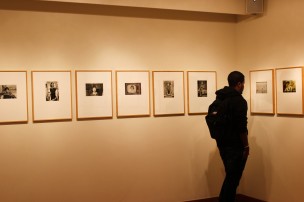A man smiling behind a melting popsicle; a grandmother braiding the hair of her studious granddaughter; another man selling scraps of tin on a street; a bricklayer; an egg vendor with his eggs piled up in front of him—these are just a few of the images that are displayed in “Faces of China, 1981” at the Mansfield Freeman Center for East Asian Studies. The exhibition allows viewers a glimpse into the life of the Chinese workers and middle class at the beginning of Deng Xiaoping’s Reform and Opening Up policy in 1981. The photographer, Tom Zetterstrom, portrays this changing culture in a diverse and endearing way.
The majority of the photos are portraits, and to capture the shots, Zetterstrom said at Wednesday’s gallery opening, he essentially laid down in front of his subjects. This intimacy between artist and subject was a challenge for Zetterstrom—he described his Chinese language skills as “pathetic,” and noted that he was able to bond with the people in his photographs purely through his approach of being an innocent and foreign photographer asking to document their lives. Zetterstrom focused specifically on hands and faces in his photographs.
“I was allowed to go totally free with no assignment, no knowledge, complete ignorance, and I think their roles in life drew me to them,” Zetterstrom said. “Their extraordinarily tough and hard life was expressed in their faces, and I think I just saw a depth there.”
These “extraordinarily tough and hard” lives were a result of living through the Cultural Revolution, the social-political movement set forth by Mao Zedong from 1966 to 1976 that Zetterstrom said crippled China politically, economically, and socially. Zetterstrom said that by being able to photograph a society emerging from such a tumultuous time, he was able to experience their culture in a totally unique way.
“I just think that I was open to it,” Zetterstrom said. “And within a week or two, I had a sense that this is what truly interests me.”
As I wandered around the room looking at the photographs, many indicated the presence that Mao Zedong had in the daily life of the Chinese people during this era. Zetterstrom subtly contrasts the still-present traditional values and the impending shift toward modernity. One of the photos depicts a television screen showing a program with a woman in it, while another showcases an Imperial Official dressed in all his regalia. These opposing truths are the core of Zetterstrom’s exhibition, and show how China was on the brink of complete change, but was still grasping at a few strings that connected it to older, more traditional values.
Richard Field, a retired professor who taught at the University for years, and was formerly the curator of the Davison Art Center, attended the gallery opening.
“[An artist must] always be aware of how they are affecting the viewers,” Field said.
Field explained that he was a huge fan of the collection and the approach that went with it: Zetterstrom had figured out how to intimately portray his subjects in their world.
The exhibit was both moving and whimsical, introspective and informative. Every student that has even an hour to spare between now and December should venture out to the Mansfield Freeman Center for East Asian Studies and take a peek into what life was like in 1980s China.

Comments are closed